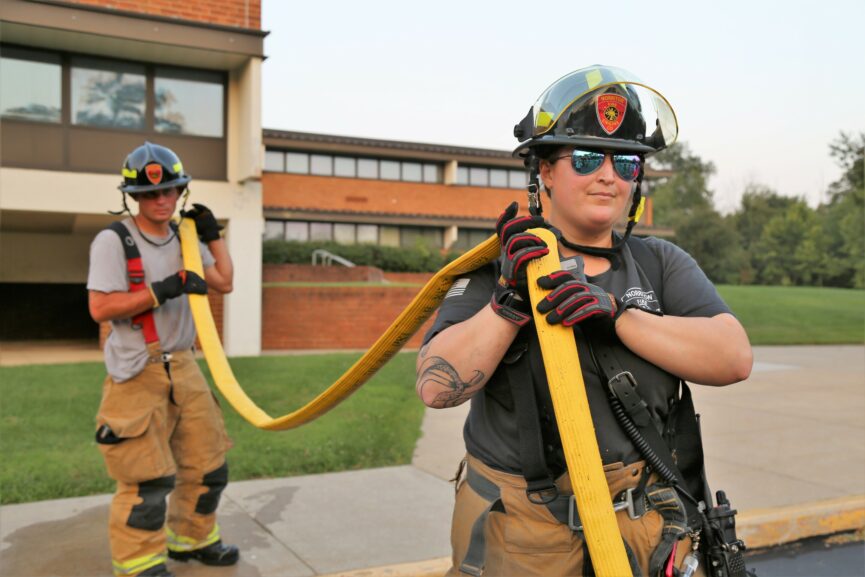Every Monday at 7 p.m. the volunteer firefighters of Norriton Fire Engine Company meet at the station for drill night. Depending on the topic and the amount of clean up, drill nights usually last between two to three hours.
“Drill nights vary from week to week to keep training exciting,” said Battalion Chief-2 Michael Barnshaw. “We may have drill in a classroom setting and the following week, take what was learned and use it in a hands-on session.”
As Battalion-2, Barnshaw is in charge of topics for drill nights, but all officers add input and assist in teaching. Norriton Fire Engine Company provides all gear and training to volunteers as well.
Recently, drill nights have been going back to the basics because of all the newer members who have joined in the past year. During the first week of back-to-the-basics drill nights, officers taught members how to use personal protective equipment (PPE) and air packs, which consists of a face mask connected to a portable air supply to allow firefighters to breathe in smoky conditions and intense heat. After practicing, members had the option to enter a competition to see who could change the fastest out of street clothes to full firefighter turnout gear and be the first to breathe from the air pack.
The following week, members learned techniques to mask up faster and in the third week, members learned hose line advancement. Then the past three weeks of topics were combined into one drill to put their skills into action.
Norriton Fire Engine Company also recently acquired a structure that they could train in and flow water at. Before the building was taken down, the officers held many drill nights there on proper hose deployment in various emergency scenarios. Additionally, firefighters learned how to complete a roof cutting on a commercial roof.
“It was a team building event because Norriton Fire Engine Company invited a neighboring fire department, Centre Square Fire Company to train on that type of roof construction,” said Barnshaw.
While that was exciting for the volunteers, another topic they really enjoy and broadens their scope of training is vehicle rescue.
“We must be able to remove the patients in the quickest and most efficient way possible without injuring them further,” said Barnshaw. “During a drill, volunteers get the chance to assess the situation and recognize that every vehicle rescue is different. What worked in one situation may not work the next time.”
Before Barnshaw joined Norriton Fire Engine Company, he volunteered with Centre Square Fire Company and had the opportunity to take a vehicle rescue class at Howell Rescue School in Ohio. He learned different ways to free people from vehicles and what situations to use them in.
“One specifically was called the ‘winter cut’ where you cut a small hole in the windshield and leave all the doors on the car, so the patient stays warm in the winter,” said Barnshaw.
Then a volunteer drops a chain through the hole and wraps the steering wheel. They pull the chain back up and use the spreaders to pull the steering column away from the patient. The spreaders are also known as Jaws of Life.
“As the member begins to open the spreaders, the chain tightens and the steering wheel is pulled up, freeing the patient,” explained Barnshaw. “After that is completed, the doors can be removed quickly to extricate the person.”
A year later, this very same training was put into action at a vehicle rescue call. “I was able to use all the information I learned to complete the extrication of the patient,” he said.
Barnshaw encourages members to show up to as many of the station’s drill nights as they can because it promotes team building and creates a bond with all the members. “It also helps familiarize the volunteers with the apparatus that they ride and the tools they have at their disposal for all different types of calls,” he said.
Along with the station’s drills, new volunteer firefighters attend training at the Montgomery County Fire Academy to earn their Firefighter I certification. Training is broken down into four sections: Introduction to the Fire Service, Fire Ground Support, Exterior Firefighting and Interior Firefighting. Besides classroom instruction at the fire academy, facilities for training include a structural burn building for interior firefighting training, a drill tower for aerial apparatus and ladder work, a smoke house for search and rescue skills, a drafting pit for water supply pump training and a flammable gas pad for flammable gas and fire extinguisher training.
Many Norriton Fire Engine Company volunteers strive to obtain higher levels of training and become certified at state and national levels for firefighting and rescue disciplines. In addition to local training, volunteers have trained at the Pennsylvania State Fire Academy, National Fire Academy, PA and Federal Emergency Management Agencies, and many others.
“If members want to continue their education, Norriton Fire Engine Company can support them in taking more classes and growing as firefighters,” said Barnshaw.
Popular classes to take after Firefighter I are Vehicle Rescue Technician, Firefighter II, Fire Instructor I and Fire Officer I.
“Continuing education is important in all aspects of life and not only firefighting,” said Barnshaw. “If there is ever a point in your life where you do not feel you are where you want to be, take a class, learn a trade and be better for the person that looks up to you. Set the example for others to follow and everyone will then have the groundwork to grow and be successful together.”
While volunteering and training is a time commitment, volunteers are only asked to donate as much time as they can and are not expected to attend all calls or drills. In addition to volunteer firefighters, Norriton Fire Engine Company is seeking fire police, junior volunteers ages 16 and 17, and administrative members.

